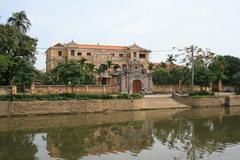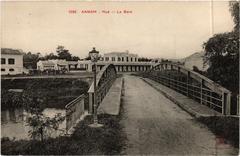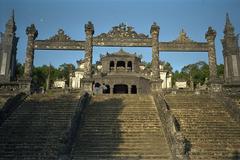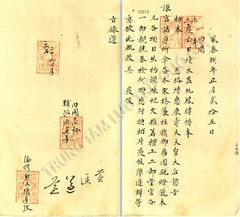Comprehensive Guide to Visiting Huế, Thừa Thiên Huế, Vietnam
Date: 13/08/2024
Introduction
Imagine stepping into a city where every corner whispers tales of emperors and warriors, ancient ruins stand as silent sentinels of a bygone era, and the air is thick with the aroma of incense and tantalizing scents of local cuisine. Welcome to Huế, a city that is not just seen but felt in every sense. Once the glittering jewel in the crown of Emperor Gia Long, the first ruler of the Nguyễn Dynasty, Huế was the capital of a unified Vietnam from 1802 to 1945 (History Hit). The city is a living museum, with the Imperial City, a UNESCO World Heritage Site, standing as a testament to its grand past (UNESCO).
But Huế is more than its historical landmarks. The city’s vibrant culture, influenced by its ancient roots and French colonial past, offers a sensory overload. From the rhythmic chanting heard in pagodas to the bustling chatter of Dong Ba Market, Huế engages all your senses. And let’s not forget the food! The spicy kick of bun bo Hue and the sweetness of local desserts are a culinary adventure in their own right.
As you explore Huế, you’ll uncover hidden gems and local secrets that go beyond the obvious tourist attractions. Whether it’s a stroll across the vibrantly lit Truong Tien Bridge at night or discovering the panoramic views from Vong Canh Hill, Huế offers countless surprises. So, get ready to dive deep into the enchanting tapestry of Huế, Thừa Thiên Huế, Vietnam, where history, culture, and sensory experiences intertwine to create an unforgettable journey.
Table of Contents
- The Enchanting Tapestry of Huế, Thừa Thiên Huế, Vietnam: A Journey Through Time and Senses
- A First Glimpse
- The Ancient Beginnings
- The Nguyễn Dynasty Era: The Golden Age
- French Colonial Influence: A Touch of Europe
- The Vietnam War and the Battle of Huế: A City Under Siege
- Post-War Restoration and UNESCO Recognition: A Phoenix Rising
- Key Historical Sites in Huế: Must-See Marvels
- Hidden Gems and Local Secrets: Beyond the Obvious
- Sensory Overload: Feel Huế With All Your Senses
- Interactive Exploration: Your Huế Quest
- Cultural Context and Etiquette: When in Huế…
- Practical Information with a Twist: Fun and Functional
- Pop Culture and Huế: Lights, Camera, Action!
- Time-Based Itineraries: Choose Your Adventure
- Local Lingo Lessons: Talk Like a Local
- Seasonal Highlights: The Many Moods of Huế
- Myth Busting and Surprises: Did You Know?
- Storytelling Elements: Legends and Lore
- FAQ: Quick Answers for the Curious
- Call to Action: Discover Huế with Audiala
- Major Attractions in Huế, Thừa Thiên Huế, Vietnam
- The Ultimate Guide to Cultural Events in Huế, Thừa Thiên Huế, Vietnam
The Enchanting Tapestry of Huế, Thừa Thiên Huế, Vietnam: A Journey Through Time and Senses
A First Glimpse
Imagine stepping into a city where every corner whispers tales of emperors and warriors, ancient ruins stand as silent sentinels of a bygone era, and the air is thick with the aroma of incense and tantalizing scents of local cuisine. Welcome to Huế, a city that is not just seen but felt in every sense.
The Ancient Beginnings
Huế’s history kicks off with a whisper from the ancient city of Kandarpapura, part of the Champa Kingdom from 192 to 605 AD. Ruins nestled on Long Tho Hill whisper secrets just three kilometers west of modern Huế. Fast forward to 1307, and the city gets a makeover and a new name, Amarendrapura, but it’s soon enveloped into the expanding Vietnamese territory.
The Nguyễn Dynasty Era: The Golden Age
Zoom into 1802, and Huế becomes the glittering jewel in the crown of Emperor Gia Long, the first ruler of the Nguyễn Dynasty. The city morphs into the capital of a unified Vietnam, with the construction of the magnificent Imperial City starting in 1804. This Citadel, with its imposing walls and majestic moat, becomes Vietnam’s political, cultural, and religious heart (History Hit).
The Imperial City, a city within a city, is a wonderland of palaces, shrines, gardens, and villas. At its heart lies the Forbidden Purple City, the emperor’s private playground, off-limits to all but the emperor, his family, and a few trusted souls (Wikipedia).
French Colonial Influence: A Touch of Europe
The 1880s brought French flair to Huế, turning it into the Imperial Palace of the French protectorate of Annam. The city’s architecture began to reflect European styles, blending seamlessly with its Vietnamese roots. This era lasted until 1945, culminating in the abdication of Emperor Bao Dai and the dawn of the Democratic Republic of Vietnam (Vinpearl).
The Vietnam War and the Battle of Huế: A City Under Siege
The Vietnam War painted Huế in darker hues, with the city becoming a strategic hotspot due to its proximity to the North-South demarcation line. The Battle of Huế in 1968, part of the Tet Offensive, was a brutal clash that left the city, especially the Imperial City, scarred and battered (Mihi Travel).
Despite the devastation, Huế rose from the ashes, with extensive restoration efforts breathing new life into its historic and cultural heritage (You in Da Nang).
Post-War Restoration and UNESCO Recognition: A Phoenix Rising
The post-war years saw Huế’s monuments being meticulously restored. In 1993, the Complex of Huế Monuments earned its place as a UNESCO World Heritage Site, a testament to its universal value. The complex, including the Imperial City and the Forbidden Purple City, stands as a proud reminder of the Nguyễn Dynasty’s grandeur (UNESCO).
Key Historical Sites in Huế: Must-See Marvels
The Citadel
The Citadel is Huế’s crown jewel, an eastern feudal city that houses several key historical structures:
- Meridian Gate: The emperor’s exclusive entrance to the Imperial City.
- Thai Hoa Palace: The majestic throne room where the emperor held court.
- Forbidden Purple City: The emperor’s private residence, now a site of ongoing restoration (You in Da Nang).
Royal Tombs
The royal tombs along the Perfume River are a must-visit, each reflecting the personality of the emperor it commemorates:
- Tomb of Emperor Minh Mang: Traditional Vietnamese architecture set in a serene landscape.
- Tomb of Emperor Khai Dinh: A blend of Vietnamese and European styles.
- Tomb of Emperor Tu Duc: A sprawling complex of pavilions, temples, and a lake (Wanderlog).
Thien Mu Pagoda
The Thien Mu Pagoda, Huế’s largest, has stood since 1601 as a symbol of the city’s rich heritage. It offers stunning views of the Perfume River and is a beloved spot for both tourists and locals (You in Da Nang).
Hidden Gems and Local Secrets: Beyond the Obvious
- Truong Tien Bridge: At night, this iconic bridge lights up in vibrant colors, a perfect spot for an evening stroll.
- Dong Ba Market: Dive into the local culture and sample exotic foods, from bun bo Hue to che, a sweet dessert soup.
- Vong Canh Hill: A lesser-known spot offering panoramic views of the Perfume River and the surrounding countryside.
Sensory Overload: Feel Huế With All Your Senses
- Sight: The vibrant colors of traditional áo dài dresses, the majestic architecture of the Citadel.
- Sound: The rhythmic chanting from pagodas, the bustling chatter of Dong Ba Market.
- Smell: Incense wafting from temples, the rich aroma of Vietnamese coffee.
- Taste: The spicy kick of bun bo Hue, the sweetness of local desserts.
- Touch: The cool stone of ancient ruins, the soft silk of traditional garments.
Interactive Exploration: Your Huế Quest
- Challenge: Find the hidden dragon motifs within the Imperial City. Hint: They symbolize power and protection.
- Mini-Quest: Try making a local dish at a cooking class and share your creation on social media with the hashtag #TasteOfHue.
Cultural Context and Etiquette: When in Huế…
- Greeting: Say “Xin chào” (hello) with a smile. A slight bow shows respect.
- Dress Code: Modest clothing is appreciated, especially when visiting temples and historical sites.
- Dining: Use chopsticks properly and avoid sticking them upright in your bowl—it’s considered bad luck.
Practical Information with a Twist: Fun and Functional
- Weather: November to April is cool and comfy, ideal for exploring. Summer (June to August) is hot but perfect for beach lovers (Hi Vietnam).
- Guided Tours: Local guides are like walking encyclopedias with a dash of humor. Book one to uncover Huế’s secrets (Backpackers Wanderlust).
- Exploring the Citadel: Enter through Ngọ Môn gate and exit through Cửa Hiển Nhơn gate to save your feet some trouble (There She Goes Again).
Pop Culture and Huế: Lights, Camera, Action!
- Movies: Huế’s Imperial City was a backdrop in the film.
Major Attractions in Huế, Thừa Thiên Huế, Vietnam
Welcome to Huế, where the past meets the present in a symphony of colors, sounds, and scents. Did you know that Huế was the capital of Vietnam for over 140 years? Let’s dive into a journey through time and discover Huế’s charm and secrets.
The Imperial City of Huế
Feel like royalty for a day at the Imperial City, your palace for exploration. This UNESCO World Heritage Site, constructed in the early 19th century, was the epicenter of the Nguyễn Dynasty. Wander through the Capital Citadel, Royal Citadel, and Forbidden Purple City, where grand palaces and temples await. Don’t forget to count the dragon motifs – see if you can spot them all! Open daily from 8:00 AM to 5:30 PM, with extended hours on Thursdays. Tickets: 200,000 VND for adults, 40,000 VND for children. Challenge: Can you find the hidden courtyard where the emperors used to meditate?
Thien Mu Pagoda
Feel the serenity at Thien Mu Pagoda, perched on the northern bank of the Perfume River. Established in 1601, its seven-story Phước Duyên Tower is a Huế icon. The scent of incense fills the air as you explore halls, shrines, and a tranquil garden. Accessible by bicycle or dragon boat, it’s open daily from 8:00 AM to 6:00 PM. Fun fact: This pagoda inspired scenes in the famous Vietnamese novel, “The Tale of Kiều.”
Tomb of Minh Mang
About 12 kilometers from Huế lies the Tomb of Minh Mang, a harmonious blend of architecture and nature. Completed in 1843, this final resting place of Emperor Minh Mang features courtyards, pavilions, and lakes. Open daily from 7:00 AM to 5:30 PM. Tickets: 150,000 VND for adults, 30,000 VND for children. Seasonal highlight: Visit in spring to see cherry blossoms in full bloom.
Tomb of Tu Duc
Nestled in a lush pine forest 8 kilometers from Huế, the Tomb of Tu Duc is both a summer retreat and final resting place for Emperor Tu Duc. Built between 1864 and 1867, it boasts a lake, pavilions, temples, and the emperor’s tomb. Open daily from 7:00 AM to 5:30 PM. Tickets: 150,000 VND for adults, 30,000 VND for children. Myth buster: Despite popular belief, Emperor Tu Duc was never buried here.
Perfume River
Think of the Perfume River as Huế’s own Instagram filter – everything looks better at sunset! Take a dragon boat tour and soak in the scenic beauty. The river’s golden hues at dusk are a sight to behold. Popular activities include stops at historical sites along the river. Movie moment: Featured in the 1992 film “The Scent of Green Papaya.”
Thanh Toan Bridge
Thanh Toan Bridge, an 18th-century wooden bridge in Thanh Thuy Chanh village, is a picturesque spot influenced by Japanese and Chinese styles. Open 24 hours and free to visit, it’s perfect for a peaceful stroll or great photos. Interactive element: Try the local tradition of making a wish while crossing the bridge.
Bach Ma National Park
Calling all nature lovers! Bach Ma National Park, 40 kilometers from Huế, spans 220 square kilometers of lush forests, waterfalls, and diverse flora and fauna. Open daily from 7:00 AM to 5:00 PM. Tickets: 60,000 VND for adults. Challenge: Can you spot the elusive red-shanked douc langur?
Huế Festival
Huế Festival is a biennial celebration of the city’s rich heritage. The 2024 festival, themed “Huế – The Essence of Vietnamese Culture,” promises vibrant parades, traditional music, and culinary delights. Seasonal highlight: Experience the lantern festival during the autumn moon.
FAQ Section
Q: When is the best time to visit Huế?
A: The best time to visit is from January to April when the weather is mild and pleasant.
Q: Is Huế safe for solo travelers?
A: Yes, Huế is generally safe, but always stay aware of your surroundings.
Q: Can I use US dollars in Huế?
A: It’s best to use Vietnamese Dong (VND), but some places accept USD.
Call to Action
Ready to uncover Huế’s secrets? Let Audiala be your guide! With our audio tours, expert insights, and hidden gem tips, your adventure through Huế will be unforgettable.
Call to Action
As we conclude our journey through Huế, Thừa Thiên Huế, Vietnam, it’s evident that this city is a remarkable blend of historical grandeur and vibrant contemporary culture. From the majestic Imperial City to the serene Thien Mu Pagoda, Huế’s landmarks are not just sights to behold but experiences to immerse yourself in. The city’s rich history, marked by the rise and fall of dynasties and the scars of war, is a testament to its resilience and enduring spirit (Mihi Travel). Today, Huế stands proudly as a UNESCO World Heritage Site, a symbol of Vietnam’s cultural heritage and historical significance (UNESCO).
But what truly sets Huế apart is its ability to engage all your senses. The vibrant colors of traditional áo dài dresses, the rhythmic sounds from pagodas, the rich aromas of local cuisine, and the tactile experience of ancient ruins all come together to create a sensory symphony that is uniquely Huế. And as you embark on this sensory journey, you’ll discover that Huế is not just a destination but an experience that stays with you long after you’ve left.
Ready to uncover Huế’s secrets? Let Audiala be your guide! With our audio tours, expert insights, and hidden gem tips, your adventure through Huế will be unforgettable. Download Audiala now and start your journey into the heart of Vietnam’s enchanting past.
References
- History Hit, 2023, Imperial City of Huế
- UNESCO, 2023, Complex of Huế Monuments
- Mihi Travel, 2023, A Tapestry of History, Culture, and Unparalleled Beauty
- Vinpearl, 2023, Huế, Vietnam: All You Need to Know About the Ancient Capital
- You in Da Nang, 2023, Huế
- Wanderlog, 2023, Most Historic Buildings and Sites in Huế
- Hi Vietnam, 2023, Huế Travel Guide
- Backpackers Wanderlust, 2023, Imperial City of Huế
- There She Goes Again, 2023, Best Things to Do in Huế, Vietnam


















